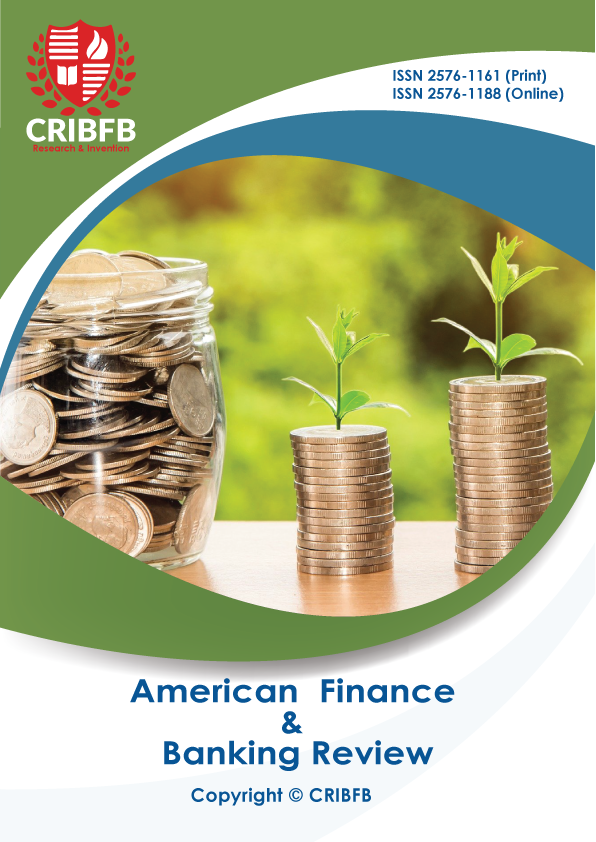Financial Conditions Index and Economic Performance in Nigeria
Main Article Content
Abstract
The main aim of this study is to construct a financial conditions index for Nigeria and analyze its predictive power for future growth rate and inflationary trend. The study is based on yearly time series data from 1985 to 2018. The variables included in the construction of the index are riskless interest rate, stock market index, exchange rate, credit to private sector and interest rate spread. The weights attached to these variables are derived from ARDL coefficients, while the predictive power of the constructed index is examined within the VAR framework. The results from the ARDL model shows that credit to private sector and stock market index are the most significant factors for nominal GDP, hence having a substantial weight in the resultant financial conditions index. However, the results from VAR impulse response function and forecast error variance decomposition suggest that the constructed financial conditions index contain very little predictive information about future growth rate and inflationary trend.
Downloads
Article Details
Section
How to Cite
References
Acaravci, A., Ozturk, I., & Acaravci, S. K. (2007). Finance-growth nexus: Evidence from Turkey. International Research Journal of Finance and Economics, 11, 30-40.
Al-Malkawi, H. A. N., & Abdullah, N. (2011). Finance-growth nexus: evidence from a panel of MENA countries. International Research Journal of Finance and Economics, 63(63).
Angelopoulou, E., Balfoussia, H., & Gibson, H. D. (2014). Building a financial conditions index for the euro area and selected euro area countries: what does it tell us about the crisis?. Economic Modelling, 38, 392-403.
Ibrahim, S., Abdullahi, A. B., Azman-Saini, W. N. W., & Rahman, M. A. (2017). Finance-Growth Nexus: Evidence-based on New Measures of Finance. International Journal of Economics & Management, 11(1).
Ipeghan, I. Y. O., & Marshall, E. S. (2019). Modeling Capital Market Performance Indicators, Financial Development and Economic Growth in Nigeria: Empirical Evidence.
Kabundi, A., & Mbelu, A. (2020). Estimating a time-varying financial conditions index for South Africa. Empirical Economics, 1-28.
Khundrakpam, J. K., Kavediya, R., & Anthony, J. M. (2017). Estimating Financial Conditions Index for India. Journal of Emerging Market Finance, 16(1), 61-89.
Ncanywa, T., & Mabusela, K. (2019). Can financial development influence economic growth: The sub-Saharan analysis. Journal of Economic and Financial Sciences, 12(1), 1-13.
Okunlola, O. A., Masade, E. O., Folaranmi Lukman, A., & Ajayi Abiodun, S. (2020). Investigating Causal Relationship between Financial Development Indicators and Economic Growth: Toda and Yamamoto Approach. Iranian Economic Review, 24(1), 225-246.
Olaniyan, T. O. (2019). Interactive Effects of Remittances and Financial Sector Development on Economic Growth in Nigeria. Remittances Review, 4(1), 19-39.
Olayungbo, D. O., & Quadri, A. (2019). Remittances, financial development and economic growth in sub-Saharan African countries: evidence from a PMG-ARDL approach. Financial Innovation, 5(1), 9.
Oro, O. U., & Alagidede, P. (2018). The Nature of Finance–Growth Relationship: Evidence from a Panel of Oil-Producing Countries. Economic Analysis and Policy. Available at SSRN 3190069.
Schumpeter, J. A. (1912). 1934. The theory of economic development.
Swiston, A. (2008). A US financial conditions index: putting credit where credit is due (No. 8161). International Monetary Fund.
Wang, S., Xu, F., & Chen, S. (2018). Constructing a dynamic financial conditions indexes by TVP-FAVAR model. Applied Economics Letters, 25(3), 183-186.




